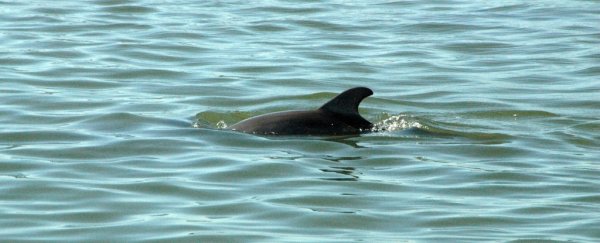Antibiotic-resistant superbugs are a growing threat to human health, and without urgent and widespread action, experts warn we might one day slip into a 'post-antibiotic era'. As the world heads down this dangerous road, it looks more and more like we're dragging marine creatures along with us.
A long-term study has now found a surge in antibiotic resistance in pathogens isolated from wild bottlenose dolphins (Tursiops truncatus) in Florida's Indian River Lagoon, and it looks like it's at least partly our fault.
When the team analysed thirteen years' worth of data based on swab samples taken from the animals, they found 88 percent of all the 733 pathogens detected were resistant to at least one antibiotic. Several of the organisms found are known to also infect humans.
While antibiotic resistance among bottlenose dolphins in this region has been documented before, few studies have examined this trend over a span as long as this one, and the findings are a cause for concern.
"In 2009, we reported a high prevalence of antibiotic resistance in wild dolphins, which was unexpected," says Adam Schaefer, an epidemiologist at Florida Atlantic University (FAU).
"Since then, we have been tracking changes over time and have found a significant increase in antibiotic resistance in isolates from these animals."
The trend, he says, looks oddly similar to what's happening in human health care settings.
Today, we are slowly coming to learn that the rapid emergence of drug-resistant bacteria is occurring worldwide, not just in our hospitals but also, it appears, in the world's oceans.
Recent research suggests that seawater is a vast global reservoir for antibiotic resistance genes. A decade ago, a team of scientists at NOAA warned this was a rising concern in marine ecosystems.
When humans take antibiotics, our bodies only partly metabolise the medication and a large amount of it is excreted in our urine and faeces. As such, it's possible that human antibiotics or antibiotics given to livestock are slipping past our wastewater treatment plants, many of which are not designed for antibiotic removal, and ending up in our oceans .
As the medicine continues to build up in the marine environment, it looks as though aquatic animals are becoming chronically exposed to a mix of chemicals. Even at low concentrations, we know that can have toxic effects.
"Bottlenose dolphins are a valuable sentinel species in helping us understand how this affects human and environmental health," says Gregory Bossart, chief veterinary officer at Georgia Aquarium.
In the study, a total of 733 isolates were obtained from 171 individual dolphins in Florida's Indian River Lagoon in the period from 2003 to 2015, with samples collected from the blowhole, the stomach, and the animals' faeces.
Among all the strains of bacteria found in the dolphins, antibiotic resistance increased significantly over the years, and was highest with the antibiotics erythromycin (92 percent), ampicillin (77 percent), and cephalothin (61 percent).
When it came to E. coli samples, resistance to the antibiotic ciprofloxacin more than doubled, and levels for the pathogen Pseudomonas aeruginosa - which is responsible for respiratory system infections and urinary tract infections - was the highest recorded for any organism ever.
One of the pathogens found, called Acinetobacter baumannii, is also of substantial concern to humans, as its infection rates have increased dramatically over the past decade.
"In addition to [hospital] infections, resistant strains associated with fish and fish farming have been reported globally," says Peter McCarthy, a microbiologist at FAU.
"The high MAR index for this bacteria isolated from dolphins in the Indian River Lagoon represents a significant public health concern."
The authors say their findings reflect recent trends in human clinical infections, and while the relationship between antibiotic resistance and the aquatic environment needs to be further examined, there's reason to suspect humans are somehow involved.
The lagoon in Florida where these dolphins live hosts a large human population and has a bunch of environmental problems. In this case, Schaeffer explains to The Guardian, it could be that antibiotics are entering the lagoon via septic tanks, runoff from nearby land, or freshwater discharge from canals.
"Based on these indices, it is likely that these isolates from dolphins originated from a source where antibiotics are used regularly and that they entered the marine environment through human activities or discharges from terrestrial sources such as septic tanks," the authors of the study conclude.
But Florida isn't the only coast where this is happening and dolphins aren't the only mammals collecting these superbugs.
Earlier this year, a survey of 11 seals and porpoises in Washington State's Puget Sound found 80 percent carried antibiotic-resistant bacteria and more than half carried bacteria resistant to more than one antibiotic. The exact cause still remains undetermined, but researchers here also contend that humans likely played an important role.
More research will be needed before we can say for sure what's going on.
The findings were published in Aquatic Mammals.
